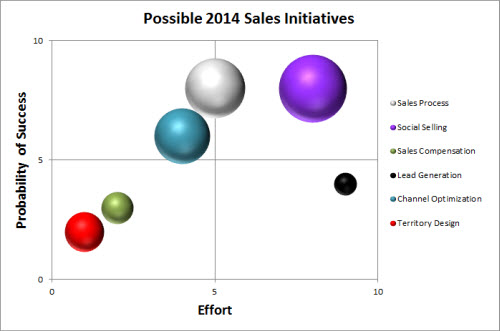Fourth quarter always poses a dilemma for Sales VP’s. How can you finish strong while building next year’s plan? This fourth quarter planning session at your office will help you. You will see how sales leaders accomplished the following:
- What initiatives should you focus on?
- What initiatives should you ignore?
- Which ones can your team execute?
- What is the impact on the ’14 revenue line?
An Iconic Sales Leader
Jim has been in sales for 25 years. 16 of these years in sales leadership. He makes the number. Jim is the guy at the end of Q2 who doesn’t panic. He knows how to sort through the noise. He has missed the number once in his 16 years. Jim is as good as it gets.
Why Jim is Good—He has figured out how to make the complex simple. Jim has decided that his team can only drive 3 initiatives per year. Some of you might say, too many. Some would say too few. Who cares? Jim picked a number. He trained his sales leadership team at each company to expect change. He taught them how to drive new initiatives while maintain consistency on existing processes.
How Jim Does It
3 Variables: Effort, Probability of Success and Return.
- Level of Effort—How much effort will the initiative take? On a scale of 1-10, can my team pull it off? Do we need outside help? Do we need a dedicated internal resource. Jim knows that change takes sustained effort. Change in the sales plan is a constant. Jim always factors in effort. Last year he rolled out a new hiring process. New hire productivity was taking too long. Jim was not convinced his field leadership team was “hiring better than their best”. He had factors working in his favor in making a change. He had a strong HR business partner and 70% of his managers had been part of the last change. This required light to moderate level of effort. They implemented a new competency model and case study method. It was deemed a success. New hire ramp time has dropped to just below 6 months from over 8.5. Victory.
- Probability of Success—how likely is the team to be successful? For example, when Jim rolled out a custom sales process two years ago, he hired a firm to help him. He did this not because he didn’t know what to do. Quite the opposite. He did this because he knew what to do. Jim knew speed and time to results would be increased with somebody else driving. Jim doesn’t care who is right. He cares what is right. He and his team wanted the latest ideas. They knew they could find them if they tried. However, success had a higher probability if they outsourced.
- Return—Jim has a basic way of evaluating return on investment. He looks at in year revenue. He ties everything back to elimination of existing waste or increase in productivity. He tackles elimination by redirecting existing dollars (trade shows) to revenue generating projects. On the productivity side, Jim uses sales calls and closing ratio. You may debate this. You might say, why not sales cycle length or deal size. And you may be right. Here is the beauty. Jim has a method. He is consistent. He focuses on “at bats” and “wins”. Simple method. It allows him to compare intiaitves. Do you have a method?

How To Understand Jim’s Plan
Red, Black and Green bubbles—these initiatives will be ignored.
Light Blue—This initiative will make it. It is low effort, relatively high success opportunity and will not impact the direct sales force. It is targeted on the channel. This will get attention.
Gray—Sales process is less effort. It has been done by Jim’s team before. Not as big a return and high probability of success. Jim and his team will drive themselves.
Purple—Social selling. This initiative has a great deal of upside. It will require high effort but has a high probability of success. Jim will use most of his investment budget to drive social selling. Technology, training, process and tools.
What Jim Would Say You Should Do Now
- Understand current state. The easiest way to do this is conduct a benchmark. If you set a baseline year over year, it will become an easier exercise.
- Complete this 2014 planning assessment. It will help you look at your sales force in a holistic fashion
- Look at each initiative against the 3 key criteria.
- Ask for help. Too many sales leaders compare their plans with their previous plans. This is not a way to incorporate best practice.
The free onsite sessions have been very enlightening for many sales leaders. We have been fortunate to conduct execution focused sessions with some of the world’s leading sales forces. View some of the commentary here. If you are behind the ’13 number, next year is a make it or break it year. If you are going to make the ’13 number, we would love to hear from you. What are you doing to build on your momentum? Share a comment below; nothing like hearing from another Jim.




